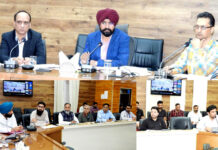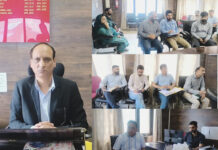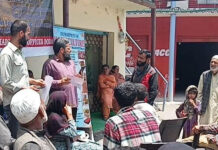London, June 24
In January this year, Professor Celeste Saulo was elected as the first woman and South American Secretary-General to the World Meteorological Organization (WMO). In an interview with Anjali Marar, Saulo, who is a teacher-researcher-academician, spoke on her scientific journey, late Indian meteorologist Anna Mani, responsibilities of developed nations to fight climate change, India’s contribution to the South Asian Meteorological services and WMO’s long-term plans to improve early warning systems.
The India Meteorological Department (IMD) is celebrating its 150th year during 2024 – 2025. How do you see India’s meteorological contributions and what role can India play towards strengthening climate services over South Asia? The India Meteorological Department is a valued and active member of WMO. Indeed, Mrutyunjay Mohapatra, was last year elected Third Vice-President of WMO.
IMD hosts the WMO Regional Specialized Meteorological Centre, New Delhi which has a proven track record of timely and accurate early warnings of tropical cyclones. These warnings have saved countless lives in recent years. For example, IMD warnings of tropical cyclone Amphan in India and Bangladesh in May 2020, underpinned a successful disaster mobilisation campaign, including the evacuation of more than 3 million people. Early warnings from RSMC New Delhi were instrumental in laying the ground for early action to limit casualties in Myanmar and Bangladesh from the extremely strong tropical cyclone Mocha, in 2023.
IMD also plays a pivotal role in the South Asian Climate Outlook Forum, which issues predictions on the Southwest monsoon and brings together meteorologists and decision-makers from the region. Many developing countries also look to IMD’s experience and expertise in developing heat-health early warnings and action plans.
In India, and world over, there are few women scientists and even fewer meteorologists / specialists in atmospheric sciences viz-a-viz males. Now as the Secretary-General, WMO, could you share your scientific journey and challenges ? What is your message to the young women scientists?
WMO’s historical photo archives from the late 1950s actually show an Indian woman surrounded by men! Her name was Anna Mani and she made invaluable contributions to both her country and the international community. She worked her way up to becoming Deputy Director-General of the India Meteorological Department and excelled in a totally male-dominated profession. She was active in a number of WMO activities and WMO honoured the centenary of her birthday in 2018.
Anna Mani should serve as an inspiration to encourage more female scientists and meteorologists in India and around the world.
I am proud to think that, as the first female Secretary-General of WMO, I can also act as a role model to young aspiring women.
What short and long-term goals do you envision for WMO? Are there any sectors or areas which need immediate climate-smart planning or intervention?
I am guided by WMO’s Strategic Plan 2024-2027, which reaffirms the WMO vision: By 2030, we see a world where all nations, especially the most vulnerable, are more resilient to the socioeconomic consequences of extreme weather, climate, water and other environmental events; and underpin their sustainable development through the best possible services, whether over land, at sea or in the air. WMO’s overriding top priority is the ‘Early Warnings For All’ initiative, announced by the UN Secretary-General in 2022, to ensure that everyone on Earth is covered by life-saving early warnings by the end of 2027.
Another top priority is implementation of a Global Greenhouse Gas Watch to inform efforts to reduce greenhouse gas emissions under the Paris Agreement.
Could you enlist some of the gap areas in the delivery or implementation of weather and climate services, globally?
There are many! For instance, early warning systems have helped decrease the number of deaths and have reduced losses and damages resulting from hazardous weather, water or climate events.
But only 50 per cent of countries worldwide report having adequate multi-hazard early warning systems. Climate, weather and water-related extremes have led to 15 times more deadly hazards in Africa, South Asia, South and Central America, and small island states. 70 per cent of all deaths from climate-related disasters have occurred in the 46 poorest countries over the past 50 years.
This is the rationale behind the Early Warnings Campaign which has prioritised 30 of the most vulnerable countries in the initial stages.We also need to close the gaps in the Basic Observing Network. The Systematic Observations Financing Facility provides grant financing and technical assistance for the sustained collection and international exchange of surface-based weather and climate observations, according to the Global Basic Observing Network regulations.
It focuses on countries with the most severe shortfalls in observations, prioritising the Least Developed Countries and Small Island Developing States and thus, contributing to strengthening climate adaptation and resilient development.
Many Asian, Latin American and African countries still do not offer climate projections or have a robust early warning system / disaster-specific weather alerts. How can WMO plan to partner-with and handhold these nations?
We need to work from the ground up, because when working with 193 members, there is a large diversity of needs, and it is crucial to understand the various subtitles.
Climate change affects us on multiple levels and in many different ways, and like all phenomena that have a global impact, it hits the most vulnerable countries the hardest.
WMO’s role is to work with meteorological and hydrological services and to empower them to focus on climate change adaptation. We need to make their actions more visible and effective through early warnings, often alongside climate services. Today, no productive activity can be planned without considering how it is impacted by weather and climate and how changes in weather and climate conditions might affect it.
How have the Covid-19 pandemic and the two ongoing wars affected efficient delivery of climate services, gathering global weather data, establishment and dissemination of early warnings?
Geo-political disturbances do, indeed, disrupt the provision of weather and climate services and can lead to the destruction of valuable meteorological observations. They also deflect attention away from humanity’s overriding challenge: Climate Change.
And it’s important to remember that conflict and instability frequently combine with extreme weather and climate change impacts to worsen hunger, displacement and poverty.
Women are more seriously affected by climate change than men. Do you think more women in leadership positions in atmospheric sciences/climate studies would help?
We definitely need more women in leadership positions in atmospheric sciences! The disproportionate vulnerability of women and girls during disasters is now common knowledge. Women are the key drivers of livelihood, especially in subsistence farming. Therefore, the economic losses resulting from natural hazards have massive impacts on them and their communities.
Evidence from Fiji and Bangladesh shows that older women and women with disabilities are among the most affected groups during and in the aftermath of disasters. A study in Tanzania showed that widows, especially the elderly and illiterate, are the most vulnerable to the impacts of climate change due to a low adaptive capacity.



























